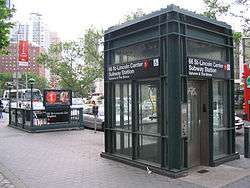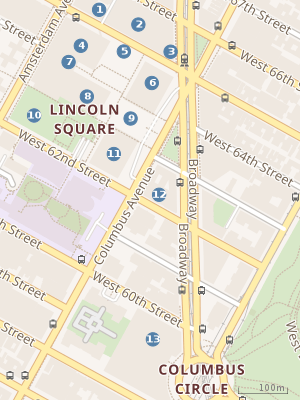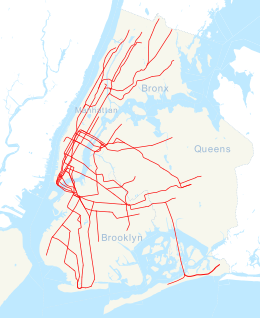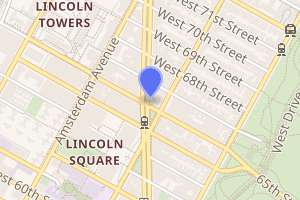66th Street–Lincoln Center station
66th Street–Lincoln Center is a local station on the IRT Broadway–Seventh Avenue Line of the New York City Subway. Located at the intersection of 66th Street and Broadway in Lincoln Square, Manhattan, it is served by the 1 train at all times and by the 2 train during late nights.
66 Street–Lincoln Center | |||||||||
|---|---|---|---|---|---|---|---|---|---|
Uptown platform | |||||||||
| Station statistics | |||||||||
| Address | West 66th Street & Broadway New York, NY 10023 | ||||||||
| Borough | Manhattan | ||||||||
| Locale | Lincoln Square, Upper West Side | ||||||||
| Coordinates | 40.774°N 73.982°W | ||||||||
| Division | A (IRT) | ||||||||
| Line | IRT Broadway–Seventh Avenue Line | ||||||||
| Services | 1 2 | ||||||||
| Transit connections | |||||||||
| Structure | Underground | ||||||||
| Platforms | 2 side platforms | ||||||||
| Tracks | 4 | ||||||||
| Other information | |||||||||
| Opened | October 27, 1904[1] | ||||||||
| Station code | 314[2] | ||||||||
| Accessible | |||||||||
| Wireless service | |||||||||
| Opposite-direction transfer available | Yes | ||||||||
| Traffic | |||||||||
| Passengers (2019) | 7,068,256[4] | ||||||||
| Rank | 54 out of 424[4] | ||||||||
| Station succession | |||||||||
| Next | 72nd Street: 1 | ||||||||
| Next | 59th Street–Columbus Circle: 1 | ||||||||
| |||||||||
| |||||||||
| |||||||||
History
Operation of the first subway began on October 27, 1904, with the opening of the original 28 stations of the New York City Subway from City Hall to 145th Street on the West Side Branch including the 66th Street station.[5]:162–191[6]
On November 29, 1962, a new entrance at the station opened, leading to the lobby of the Philharmonic Hall of Lincoln Center. The entrance led from the downtown platform of the station, but also provided access to the uptown platform by an underpass at the station's south end. This entrance was built as part of a $10.2 million underground complex by the New York City Parks Department for the Philharmonic Hall. The project was partially funded by a Federal grant, and the work was contracted out to Slattery Construction Company.[7]
Station layout
| G | Street level | Exit/entrance |
| P Platform level |
Side platform | |
| Northbound local | ← ← | |
| Northbound express | ← | |
| Southbound express | | |
| Southbound local | | |
| Side platform | ||
This underground station has two side platforms and four tracks. The two express tracks are used by the 2 train during daytime hours and the 3 train at all times.[8]
The walls at the platform level were renovated in 2004 and are decorated with mosaics designed by New York artist Nancy Spero. Elevators to street level provide ADA-accessibility. There is also a crossunder between the uptown and downtown side platforms at the extreme south end of the station; however, it is not ADA-accessible, and there is no free ADA-accessible transfer between directions.
Exits
| Exit location[9] | Exit type | Number of exits | Platform served |
|---|---|---|---|
| Staircase | 2 | Southbound | |
| Elevator | 1 | ||
| Staircase | 2 | Northbound | |
| Elevator | 1 | ||
| SW corner of Columbus Avenue and 65th Street | Staircase | 1 | Both, via southbound platform |
| Underground, from Lincoln Center | Passageway | 1 |
Nearby points of interest

| Buildings of Lincoln Center |
 |
Buildings and structures in Lincoln Center: 1 2 3 4 5 6 7 8 9 10 11 12 13 |
The station provides access to Lincoln Center for the Performing Arts just to the south, with Alice Tully Hall just to the west. All of the Lincoln Center venues are connected by underground concourses near the southern end of the station. Dante Park, upstairs at the south end, is named for the poet Dante Alighieri, whose statue is found there. Richard Tucker Park is nearby, at the north end of Lincoln Square.[9]
A number of schools are nearby as well, including the Fiorello H. LaGuardia High School of Music & Art and Performing Arts and some small schools located in the former Martin Luther King Jr. High School building.[9]
This station also provides access to:[9]
- ABC Television Center East studios, and its affiliate WABC-TV
- American Folk Art Museum
- Amsterdam Houses, New York City Housing Authority
- The Beacon School
- Leonard Bernstein Way (W. 65th Street between Amsterdam Avenue and Broadway)
- Central Park
- Church of St. Paul the Apostle
- Church of the Good Shepherd
- Ethical Culture Fieldston School, Lower School
- Fordham University Lincoln Center campus
- Holy Trinity Church
- Peter Jennings Way (W. 66th Street between Columbus Avenue and Central Park West)
- Juilliard School
- Lincoln Center for the Performing Arts
- Lincoln Square farmers market (at Richard Tucker Square)
- Lincoln Square Synagogue
- Manhattan New York Temple (Mormon)
- Merkin Concert Hall
- Museum of Biblical Art (American Bible Society)
- New York Institute of Technology
- New York Society for Ethical Culture
- West Side YMCA
References
- "Our Subway Open: 150,000 Try It; Mayor McClellan Runs the First Official Train". The New York Times. October 28, 1904. p. 1. ISSN 0362-4331. Retrieved April 21, 2020.
- "Station Developers' Information". Metropolitan Transportation Authority. Retrieved June 13, 2017.
- "NYC Subway Wireless – Active Stations". Transit Wireless Wifi. Retrieved November 13, 2019.
- "Facts and Figures: Annual Subway Ridership 2014–2019". Metropolitan Transportation Authority. 2020. Retrieved May 26, 2020.
- Walker, James Blaine (1918). Fifty Years of Rapid Transit — 1864 to 1917. New York, N.Y.: Law Printing. Retrieved November 6, 2016.
- "Subway Opening To-day With Simple Ceremony – Exercises at One O'Clock – Public to be Admitted at Seven – John Hay May Be Present – Expected to Represent the Federal Government – President Roosevelt Sends Letter of Regret" (PDF). The New York Times. October 27, 1904. ISSN 0362-4331. Retrieved May 28, 2017.
- "Philharmonic Hall Entrance To IRT Subway Opens Today". The New York Times. November 29, 1962. ISSN 0362-4331. Retrieved August 26, 2019.
- Dougherty, Peter (2006) [2002]. Tracks of the New York City Subway 2006 (3rd ed.). Dougherty. OCLC 49777633 – via Google Books.
- "MTA Neighborhood Maps: Upper West Side" (PDF). mta.info. Metropolitan Transportation Authority. 2015. Retrieved December 30, 2016.
External links

- nycsubway.org – IRT West Side Line: 66th Street/Lincoln Center
- nycsubway.org – Artemis, Acrobats, Divas and Dancers Artwork by Nancy Spero (2004)
- Station Reporter – 1 Train
- Forgotten NY – Original 28 – NYC's First 28 Subway Stations
- MTA's Arts For Transit–66th Street–Lincoln Center (IRT Broadway–Seventh Avenue Line)
- 66th Street entrance from Google Maps Street View
- 65th Street entrance from Google Maps Street View
- Platforms from Google Maps Street View



